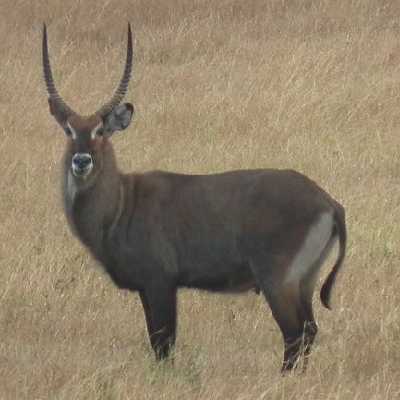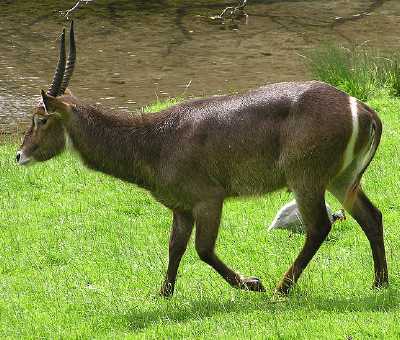| Waterbuck Kobus ellipsiprymnus
Description
This antelope has long, shaggy
hair, and a brown-gray to reddish coat that emits
an oily, smelly secretion that acts as a water
repellant.
Males bear long (up to
39 inches), heavily-ridged horns, extending back
from the head and then sweeping forward.
Body length ranges from 5.8 to 7.7 feet, and
weight from 330 to 500 pounds; males are larger
than fmales.
The two main subspecies of waterbuck are
distinguishable by their rump markings -- the defassa has wide white patches on each
side of rump, while the common has a conspicuous
white ring around a dark rump. All
waterbucks have large, rounded
ears and white patches above the eyes and around
the nose, mouth, and throat.
 
Distribution and
Habitat
The common waterbuck occurs in south-east
Africa, east of the Great Rift Valley, while the
Defassa waterbuck is found west of the Great Rift
Valley, ranging from Ethiopia west to Senegal.
They inhabit areas close to water in savanna
grasslands, gallery forests and riverine
woodlands.
Habits and Behaviors
Despite its common name, the
waterbuck is not really aquatic, but it will
often take refuge from predators in a swamp or
other large body of water.
Female and young waterbuck form herds of up to
30 individuals, which move freely through a
number of male territories Young males live
in bachelor herds, until the opportunity arises
to usurp an adult male from his territory. Each
herd has a distinct social hierarchy based on
size and strength, and contests are frequent.
Around 6 to 7 years, males become territorial,
defending them against mature rivals with
posturing and fights. These territories are
maintained throughout the year, but a male is
generally overthrown before he reaches 10 years
of age.
Reproduction
During the mating season, adult males attempt
to hold females as they wander through their
territory for mating. The gestation period
lasts about 280 days, and the female gives birth
to a single calf, which remains hidden in
vegetation for at least the first two weeks of
life. After this period, the calf begins to
join its mother and the herd, the mother's raised
tail serving as a signal to follow. The calf
is weaned at about six months. Female
waterbuck reach maturity at about three years of
age, while males leave their mother's herd at
about eight or nine months to join a
bachelor herd, but are unable to compete for
their own territory until five or six years
old. Waterbuck are known to live for up to
18 years.
Diet
Waterbuck feed on coarse
grasses not typically eaten by other grazing
animals, as well as some aquatic vegetation.
Scientific
Classification
phylum Chordata
subphylum Vertebrata
class
Mammalia
order
Artiodactyla
family
Bovidae
genus & species
Kobus ellipsiprymnus defassa defassa
waterbuck
K.e. ellipsiprymnus common waterbuck
Questions or comments about
this page?
|



